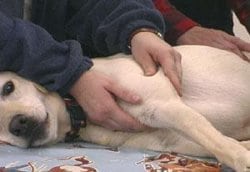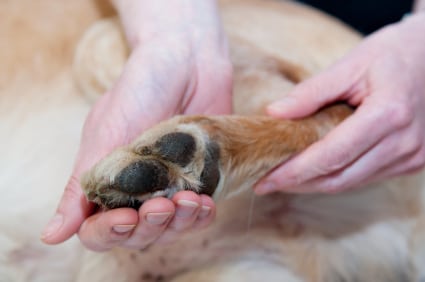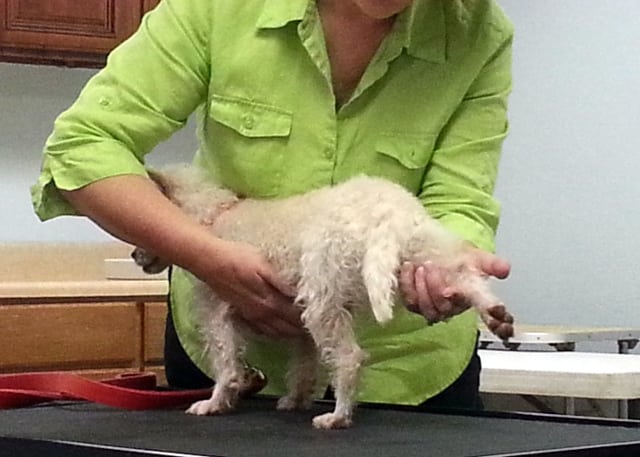Massage helps humans feel great but did you know that dogs can receive the same benefits?
In today’s guest blog post written by certified animal massage therapist Anne Fraley, owner of Cumberland Animal Massage in Tennessee, she explains why massage is one of the greatest gifts we can give our three-legged family members and how we can begin to make it a part of our special time together.
Bring Your Tripawd Into Balance
When my father was seven he contracted polio. The disease left him with a smaller, shorter, and weaker left foot and leg than his right, and as he grew into adulthood the impact of this disparity became apparent by way of a pronounced limp. Over time the bone structure of his “good” leg bore the burden of being longer and stronger. His right knee began to bow outward, the joint of his hip adjusted to a new angle of wear, and the muscles of his leg stretched and strained to keep up. By the time he was 75 he was increasingly at risk for losing his balance and falling, and twice in his later years he suffered broken bones.
How a Tripawd’s Body Compensates for Limb Loss
When a part of the body experiences a shift from its original design—whether from the likes of polio, a fracture, or an amputated limb—the rest of the body picks up the slack to compensate for the deprivation or loss of the once functioning part. Physical balance is affected, requiring shifts and changes in order to stabilize the body in motion and at rest, and muscles begin to experience new stresses. These same kinds of changes are experienced in the musculo-skeletal system of our pets when they suffer a similar loss.

When we think about the consequences of a lost limb for either humans or animals, our minds tend to go first to practical concerns like mobility. But the adjustments endured by the body are more subtle, with lasting effect. A dog or cat born without one of its limbs has a different experience than the older pet who has lived for several years with all of its appendages. The skeletal system of the young Tripawd adapts as it is developing. Bones grow larger in some areas and shrink in others to compensate for an increase or decrease in its role in the body. The same is true for muscles. In the older pet bone and muscle will also adjust, realigning, building up, and strengthening in areas where remaining limbs and joints respond to new uses and demands. Bone and muscle will likewise atrophy in areas that no longer have much function.
The Benefits of Massage for a Tripawd
How does massage assist our Tripawds with this adaptation?

At the very least, massage stimulates circulation, bringing oxygenated blood to all parts of the body. As it does so it flushes the lymphatic system, carrying toxins and other waste from throughout the body to be expelled.
Focused work on muscle groups helps relieve soreness and stretches tight muscles that can result from overuse. This is particularly helpful for the remaining hip or shoulder that now carries all of the burden of bearing the weight of the animal as it walks, runs, or in other ways ambles through its environment (taking stairs, for instance, or jumping onto, or off of, furniture).
Massage helps improve muscle tone, an important factor for that part of the body working overtime. As all parts of the Tripawd’s body is stimulated through massage its energy is brought into balance, helping the animal relax and return to its healthiest state. its immune system is also strengthened, an important issue for pets already striving to adapt to a altered anatomy.
Massage is especially helpful to our pets in the early stages of transition from a quadruped to a Tripawd, but regular, ongoing sessions are useful as a means to monitor physical stress, and become aware of any challenges the animal may face.

Learn more about massage for your pet:
Five Reasons You Should Be Giving Your Dog a Massage
Dog Massage: Isn’t Petting Enough?
Note: Animal massage is a complement to traditional veterinary care, not a substitute for it. We recommend that you consult your veterinarian before a massage session for your pet.
More Recommended Reading
Relax, and Learn How to Massage Your Tripawd
Massage Techniques and Tips for Triapwds
…just wanted to add to my previous comment, that my first point of contact and advice was, of course, a very skilled veterinarian..everything that i did myself, i would first get the ok from my vet to make sure it was the right thing for my little buddy! I just am very thankful that i received the advice to use massage to help my kitty, because it truely helped heal him & is the reason he’s pain free now. I can’t say enough about the bennefits of massage to my cat & encourage all people with tripawd friends to do this for their animal!
Thank you for adding this note!
I just came across your great article here. I have an almost four year old tripawed angora/maine coon kitty, who lost the leg last summer. I read everything i can get my hands on about animal amputees. I have rehabilitated my little boy myself & hes doing fantastic. I’ve been giving him a half an hour of massage, focussing on the hip of the missing limb, every morning after breakfast. I also massage his whole body afterwards & he loooves it! I noticed he was having phantom pains & was startled/ scared by some of the difficulties of balance/getting around,in the beginning. It was hard on the heart watching him struggle & seeing that he was feeling the phantom pains…but i just kept up the routine & all his pains have gone away.In the beginning i also did some work getting him to climb up steps & do other walking exercises with my guidance and support. I would set up a little course for him & we’d go through it together… Now he is racing around, climbing, jumping as if nothing ever happenned! It’s the good advice from people like yourself that helped me heal my little friend, both physically & mentally. A lot of love, patience & hands-on caring can achieve miracles!